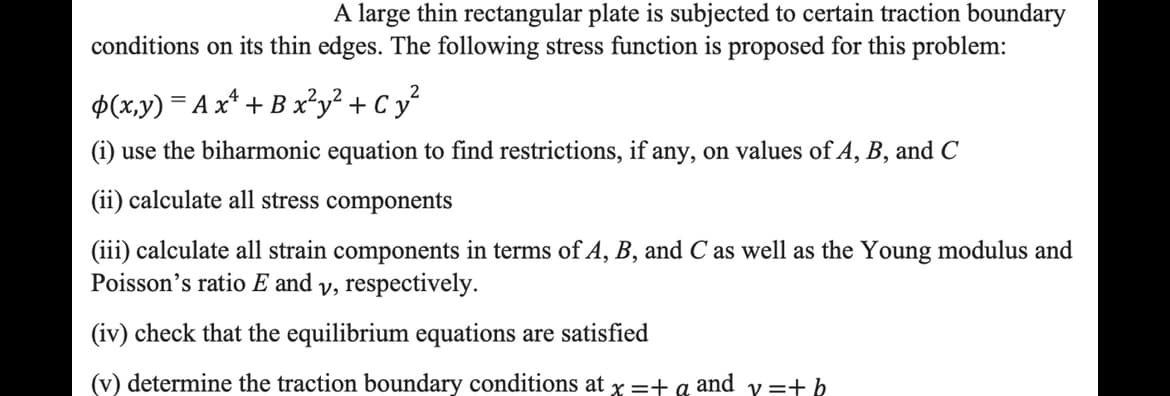A large thin rectangular plate is subjected to certain traction boundary conditions on its thin edges. The following stress function is proposed for this problem: p(x,y) = A x¹ + Bx²y² + Cy² (i) use the biharmonic equation to find restrictions, if any, on values of A, B, and C (ii) calculate all stress components (iii) calculate all strain components in terms of A, B, and C as well as the Young modulus and Poisson's ratio E and y, respectively. (iv) check that the equilibrium equations are satisfied (v) determine the traction boundary conditions at x =+q and y=+h
A large thin rectangular plate is subjected to certain traction boundary conditions on its thin edges. The following stress function is proposed for this problem: p(x,y) = A x¹ + Bx²y² + Cy² (i) use the biharmonic equation to find restrictions, if any, on values of A, B, and C (ii) calculate all stress components (iii) calculate all strain components in terms of A, B, and C as well as the Young modulus and Poisson's ratio E and y, respectively. (iv) check that the equilibrium equations are satisfied (v) determine the traction boundary conditions at x =+q and y=+h
Mechanics of Materials (MindTap Course List)
9th Edition
ISBN:9781337093347
Author:Barry J. Goodno, James M. Gere
Publisher:Barry J. Goodno, James M. Gere
Chapter3: Torsion
Section: Chapter Questions
Problem 3.2.6P: A circular aluminum tube subjected to pure torsion by torques T(sec figure) has an outer radius...
Related questions
Question
I need help with iv and v

Transcribed Image Text:A large thin rectangular plate is subjected to certain traction boundary
conditions on its thin edges. The following stress function is proposed for this problem:
2
p(x,y) = A x² + B x²y² + Cy²
(i) use the biharmonic equation to find restrictions, if any, on values of A, B, and C
(ii) calculate all stress components
(iii) calculate all strain components in terms of A, B, and C as well as the Young modulus and
Poisson's ratio E and y, respectively.
(iv) check that the equilibrium equations are satisfied
(v) determine the traction boundary conditions at x =+q and
y=+ b
Expert Solution
This question has been solved!
Explore an expertly crafted, step-by-step solution for a thorough understanding of key concepts.
Step by step
Solved in 4 steps

Knowledge Booster
Learn more about
Need a deep-dive on the concept behind this application? Look no further. Learn more about this topic, mechanical-engineering and related others by exploring similar questions and additional content below.Recommended textbooks for you

Mechanics of Materials (MindTap Course List)
Mechanical Engineering
ISBN:
9781337093347
Author:
Barry J. Goodno, James M. Gere
Publisher:
Cengage Learning

Mechanics of Materials (MindTap Course List)
Mechanical Engineering
ISBN:
9781337093347
Author:
Barry J. Goodno, James M. Gere
Publisher:
Cengage Learning